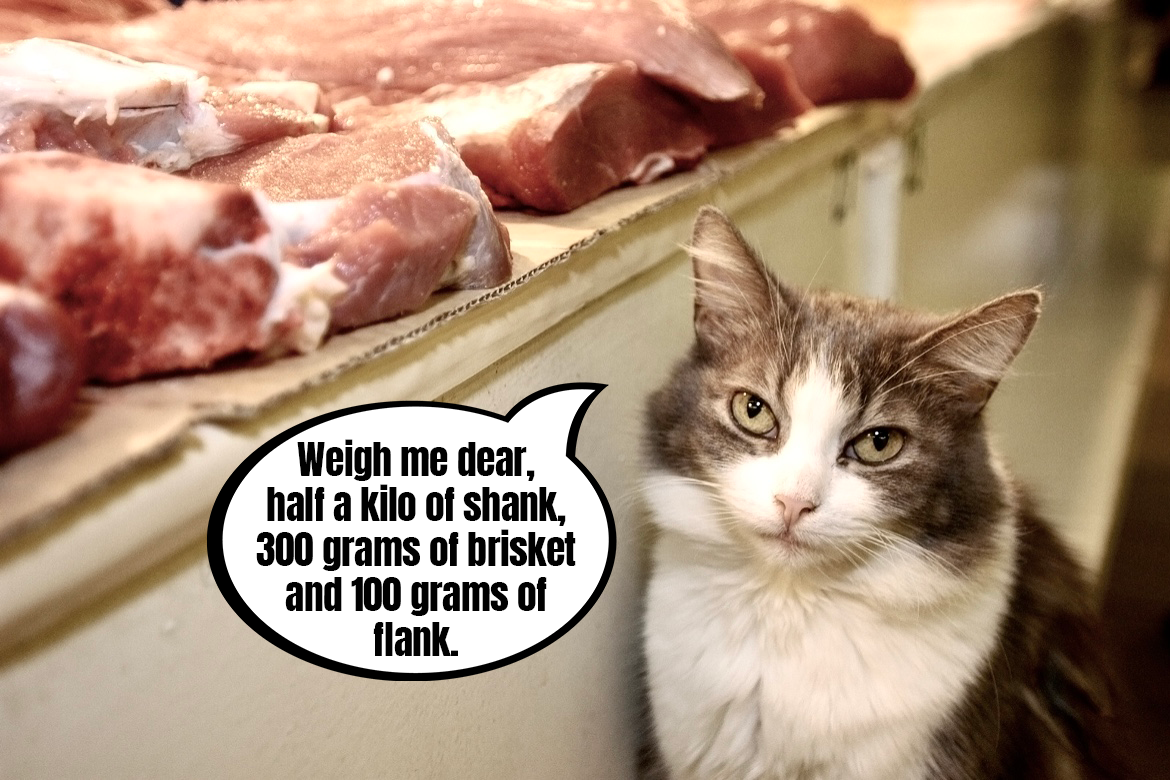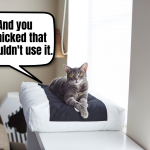Proper nutrition for cats? If it depended on their whim, our furry companions would probably ask only for a fresh piece of tuna or grab the best bites from their hooman’s plate. In nature, cats are obligate carnivores, so their at-home bowls should only get the best meats as well. As cat Guardians we have a few options to choose from in this matter. Dry food, wet (canned) food, BARF, or maybe whole prey? How can we please our cat’s bellies and raise happy, well-fed and healthy kitties?
Cat feeding methods – available options overview
Visiting a pet shop, we’ll find two main types of commercial cat food on the shelves: dry food and canned wet food. There’s obviously a huge variety of choices, not only in terms of flavours, but also the contents, textures and packaging sizes. Beside the commercial options, we can also get our cats on two different feeding methods: BARF and whole prey. They will be, accordingly, feeding with supplemented raw meat or with frozen-thawed small animals that are available for sale and bred as feeders for snakes etc. Before you choose the option that’s most suitable for you, fabCat, it’d be good to get to know the characteristics of each and every feeding method – as it turns out, not all of them will be appropriate for a cat (despite commercial success), and those that are seemingly the best might become harmful if they’re not done correctly.
Dry food
It’s by far the most convenient option from the cat Guardian’s perspective. Dry kibble poured into a bowl won’t go bad as quickly as fresh or canned meat. The texture and ingredients also makes the kibbles very liked by cats. Ongoing research from zoodieticians and cat Guardians practical knowledge show, however, that dry food is not the best option – the ingredients leave a lot to be desired, the commercial cat food often contains carbohydrates, sugars and plant-based ingredients which are completely unnecessary (or even harmful) for a cat’s diet, and even the higher-end product can lead to a serious dehydration problem.
Conclusion? Dry food is like the kitty version of fast food – it’s convenient, quick, but not that healthy in the long run and, what’s worse for any cat Guardian, it’s highly addictive – switching a cat from dry to wet food requires a lot of patience and obstinance.
Wet canned food
As an easily available alternative to dry food, canned meats are picked up by cat Guardians more and more often. It’s great, as the wet consistency of the food in cans is far less dehydrating, requires less highly-processed ingredients and preservatives and it’s closer to the cat’s natural way of eating. We purposefully used the word “closer to”, because even though wet food is better than dry kibble, you can choose better or worse options in this category as well.
For starters, commercial wet food can be divided into “complete” and “complementary”, which can be treated as a dessert or a tasty snack. The “complete cat food” cans are usually sold as pâté or pieces of meat in sauce, while the complementary food is usually a shredded fillet with broth. With the complete food, the ingredients are not only meat, but also all of the necessary nutrients and minerals like taurine and vitamins A and D. You won’t find them in the fillets, which is why after a long time of feeding only complementary food, your cat can get some dangerous nutritional deficiencies. But how to distinguish one from another? Most manufacturers and brands put the information on the packaging, but for your own safety it’s important to be able to read labels – in the complementary food you’ll find mostly fillet (from fish or chicken), with little or no additional fats, taurine, skins, oils or giblets that provide most of the necessary nutritional value.
Another problem is the quality of the cat food. The ability to read the labels and ingredients should be a basic knowledge for all cat Guardians, especially in the times of intensive and aggressive marketing strategies from many popular companies. Why? In most easily available commercial wet cat food there’s not that much meat… at all. 4% meat ingredients, usually giblets is definitely not enough for a cat who’s an obligate carnivore. Other ingredients there include carbs, sugars and fillers that can lead to many health problems, diabetes being one of them. You can find more on what to look out for and how to read the ingredients list, dear fabCats, in the link below. To sum it up shortly, however, the more meat (muscle, then giblets), the better.
BARF
And now for the more interesting and, for most cat Carers, more “exotic” feeding methods. First up, BARF, which starts to get a lot more recognition in the cat community. BARF means Biologically Appropriate Raw Food, which immediately points out that the main ingredient of the cat’s meals will be raw meat. The entire feeding model is supposed to imitate prey that cats would get in the wild. In practice, beside the meat part, the diet consists of bones, giblets and natural supplements (like nutritional yeast, taurine, blood, bone meal, fish oils) – everything perfectly balanced and precisely calculated, so that you are still providing your cat the right amount of nutrients and minerals in every meal.
BARF is not about feeding cats with raw meat bites that you have left from cooking and calling it enough or coming up with a diet yourself and giving your kitty a cooked chicken leg with carrots and rice. BARF is an art which requires precision and knowledge, but if done right, it’s considered to be one of the best feeding models for our domestic predators.
Whole Prey
Looking through the entire list, Whole Prey must be the most controversial and still not widely known feeding method among cat Guardians. If you’ve seen a cat online eating a mouse, a quail or a one-day chick at home, you’ve actually seen the Whole Prey model. It draws from the cat’s nature of hunting small prey items. This time though, the feeders are bred especially for the purpose of feeding other animals (snakes and other reptiles. The cat is not cruel to the prey, doesn’t destroy wild populations and is not vulnerable to illnesses that rodents or birds can carry in the wild. Whole Prey feeding is fully controlled by the cat Guardian, the food is served frozen-thawed and the cat can still play with the food item before eating, which imitates the natural hunting cycle.
With whole prey, the food is served as an entire animal – with fur or feathers, as that’s how it’s eaten in the wild. However, the diet should be still supplemented, like BARF, with raw egg yolks (1-2 times per week), vitamin E and fish oils rich in omega 3’s. Additionally, it’s worth going for some variety, as serving mice or rats alone is not enough for a cat. Unfortunately, the whole prey model of feeding is, compared to the other methods, the most expensive one.
What type of food is the best for your cat?
Disregarding dry food, every model of feeding mentioned on our list can be a good way of feeding a cat. Which one you choose, dear fabCats, is entirely up to You, your convenience, availability, time and budget.
Good quality canned food will be the easiest if you want to give your cat a fully nutritious meal and don’t worry about preparing it. BARF, made in bigger batches and frozen in a months-worth supply can be cheaper or as cheap as cans, although it requires a lot more time, patience, precision for calculations and… a large storage space in your freezer 🙂 Whole prey is definitely the most difficult to acquire and the most challenging method (also because of having to clean up the messy floors after the prey is eaten), but it can be a great way to enrich your kitty’s diet or serve as a snack, if you wanted to try and see your cat’s reaction to whole prey items.
As cat Guardians we should always strive for making our cat’s menu as close to their natural dietary requirements as possible. In case of any doubts, it’s always worth it to consult with a zoodietitian who specialises in cat’s and dog’s nutrition – veterinarians are specialists in many areas, but often not in nutrition and though they might know a lot about it, exact dietary recommendations are better to discuss with a cat’s dietitian.
Mixed feeding – when is variety ok?
To round things up, we’ll get quickly into the topic of mixed feeding that seems to be on the mind of many cat Carers. Mixing up different feeding methods and going for variety is obviously possible, as long as variety is and educated choice – it’s not advised to mix dry and wet food (completely different pH, which can lead to some stomach revolutions), but including whole prey items or chunks of raw meat and egg yolks as an enrichment for canned diet – go ahead! What’s more, combinations as such have their benefits – chewing on whole prey, meat chunks or whole chicken legs (raw) gives the cat a chance to naturally clean their teeth and fulfills their inner need to hunt.
What meals go into your cat’s bowls, dear fabCats? Did you know all the available models of feeding and chose the one you’re using consciously? We definitely recommend getting interested in the topic, regardless if your kitties are eating healthy or if you’re only now planning to change things up – knowing all the choices you have, it’s easier to pick the one that’s the best fit for the cat (and their Guardian) 🙂




